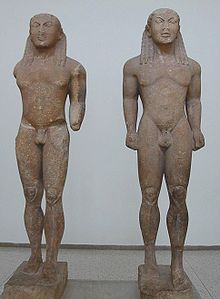In the course of its history, the culture of Ancient Greece underwent significant transformation. This paper is aimed at discussing these changes by looking at art. In particular, it is necessary to focus on sculptural works that were created between the years 650 and 100 before the Common Era.
These artworks can throw light on the development of Greek art during that period. To some extent, this development could be prompted by international relations of the Greek cities and the philosophical values which emerged in this culture. These are the main factors that should be taken into account.
At first, it is necessary to examine the sculptural works which belong to the archaic period of the Greek culture. In particular, one can mention such artworks as Kleobis and Biton, Dipylon Kouros, and the Moschophoros (see Appendixes, Pictures 1, 2, and 3). They were created during the period 600 and 570 BCE. At that time, Greek sculptors were influenced by the styles and techniques developed in Egypt and the Near East.
For example, the hairdo of the people depicted by sculptors suggests that they could familiar with the culture of Ancient Persia. The viewers can see that the sculptures have anthropomorphic features. In other words, they resemble a human being. Nevertheless, the gender distinctions are not emphasized by the authors. This argument is particularly relevant if one speaks about such a sculpture as the Moschophoros. Overall, these artworks represent the archaic period of the Greek art.
In contrast, one can look at the sculptures created during the classical period. In particular, one can look at such examples as Diadumenos by Polyclitus, Artemision Bronze, or Venus Braschi (see Appendixes, Pictures 4. 5, and 6). It is possible to identify several differences in comparison with the previous group. First of all, the sculptors tried to portray subjects in a more realistic manner.
For example, gender distinctions are clearly visible. Moreover, the artists depicted people in different poses which are rather naturalistic. Yet, the most important aspect is that the authors tried to present an idealized image of a human body. This is probably the main distinction of these artworks since these sculptures set the standards of physical beauty.
These transformations could have been caused by several important factors. In particular, one can mention the Greco-Persian Wars which started in 499. These international conflicts significantly diminished the influence of Persian culture on Greece. The techniques that one can see in the sculptures of the Archaic Period were rejected.
Moreover, the political culture and philosophy of that period set stress on such aspects as human dignity, liberty, and freedom. This is one of the reasons why sculptors tried to create an idealized image of a human being. Therefore, it is possible to say that the transformation of political ideology and philosophy gave rise to artistic changes. These are the main issues that can be identified.
This discussion indicates at several important issues. First of all, Greek sculptors tended to imitate the examples and techniques developed in the Near East and Egypt. In this case, one should focus on the works of the archaic period.
However, this trend declined after the changes in the political and intellectual life of Ancient Greece, especially the growing value of human life. This trends prompted sculptors to portray people in an idealized way. Therefore, one can argue that art is closely related to social and political life in the community.
Appendixes
Picture 1: Kleobis and Biton

Picture 2: Dipylon Kouros

Picture 3 Moschophoros

(Hurwit 27)
Picture 4: Diadumenos by Polyclitus

Picture 5: Artemision Bronze

Picture 6: Venus Braschi

(Sacks 51)
Works Cited
Gardner, Helen, and Fred Kleiner. Gardner’s Art Through the Ages: A Global History, New York: Cengage Learning, 2012. Print.
Hurwit, John. The Art and Culture of Early Greece: 1100-480 B. C, Ithaca: Cornell University Press, 1988. Print.
Sacks, David. Encyclopedia of the Ancient Greek World, New York: Infobase Publishing, 2009. Print.